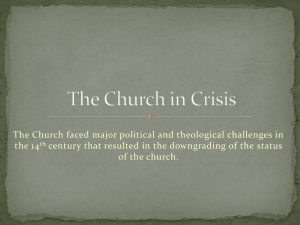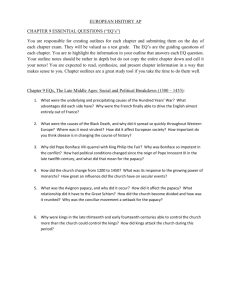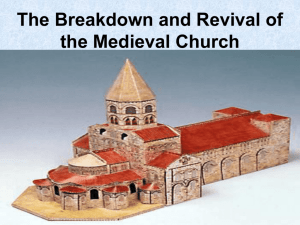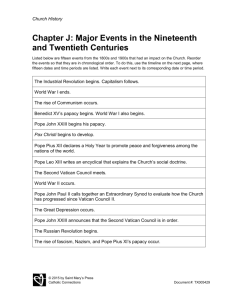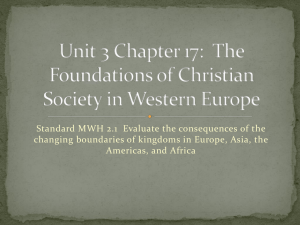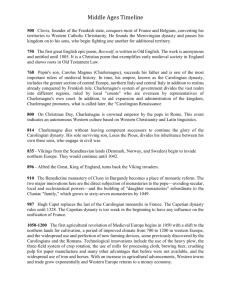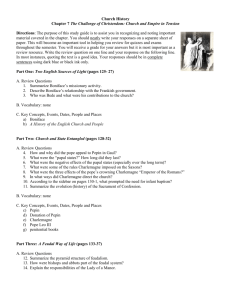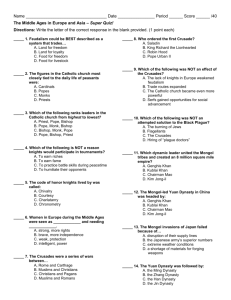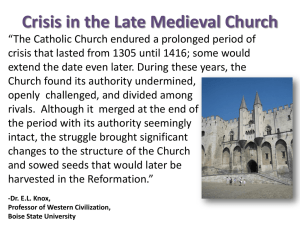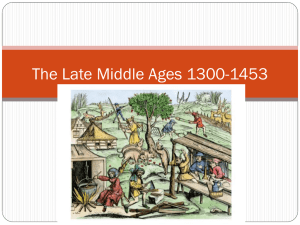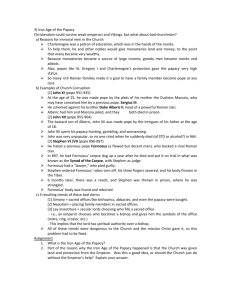Feudalism Outline
advertisement
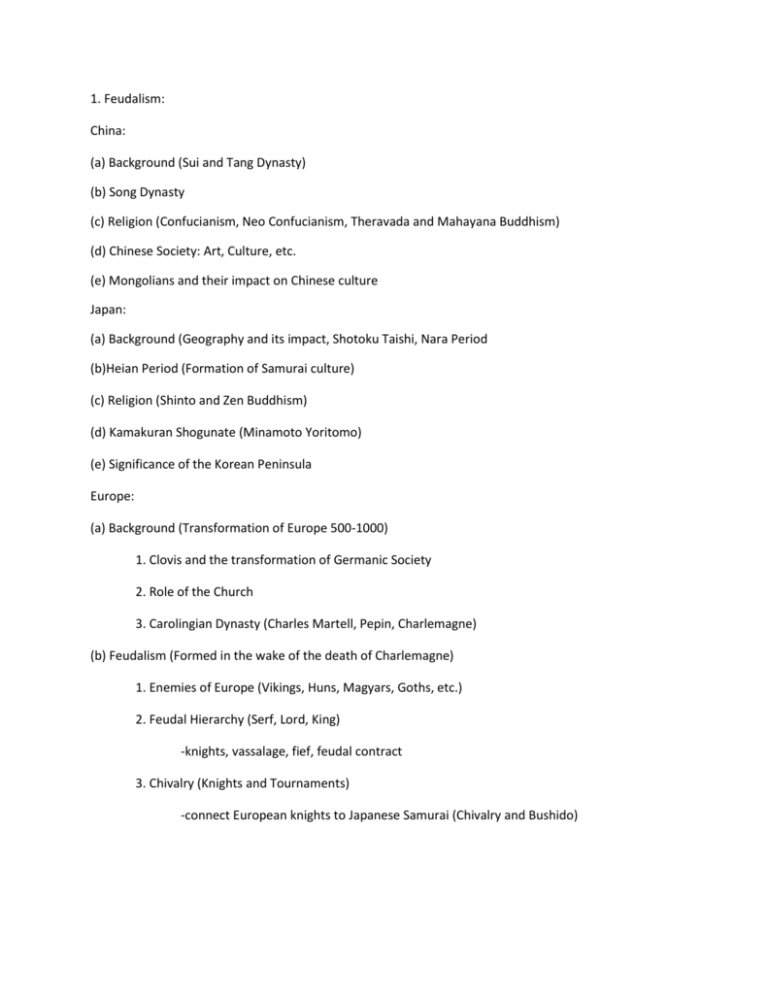
1. Feudalism: China: (a) Background (Sui and Tang Dynasty) (b) Song Dynasty (c) Religion (Confucianism, Neo Confucianism, Theravada and Mahayana Buddhism) (d) Chinese Society: Art, Culture, etc. (e) Mongolians and their impact on Chinese culture Japan: (a) Background (Geography and its impact, Shotoku Taishi, Nara Period (b)Heian Period (Formation of Samurai culture) (c) Religion (Shinto and Zen Buddhism) (d) Kamakuran Shogunate (Minamoto Yoritomo) (e) Significance of the Korean Peninsula Europe: (a) Background (Transformation of Europe 500-1000) 1. Clovis and the transformation of Germanic Society 2. Role of the Church 3. Carolingian Dynasty (Charles Martell, Pepin, Charlemagne) (b) Feudalism (Formed in the wake of the death of Charlemagne) 1. Enemies of Europe (Vikings, Huns, Magyars, Goths, etc.) 2. Feudal Hierarchy (Serf, Lord, King) -knights, vassalage, fief, feudal contract 3. Chivalry (Knights and Tournaments) -connect European knights to Japanese Samurai (Chivalry and Bushido) (c) Church influence in the Feudal System 1. William of Normandy 2. Henry II (Right to try clergy) 3. King John and the Magna Carta 4. Byzantine Empire and the Reign of Justinian (d) Great Schism (Iconoclasm, Pope Leo IX, Cardinal Humbert, Michael Cerlarius) 1. Formation of Roman Catholic Church and Greek Orthodox (e) Crusades 1. Council of Clermont 2. 1st-4th Crusade and Accomplishments of the Crusades The Middle Ages: 1. Life in Europe During Middle Ages (a) Agriculture 1. Iron 2. Role of Monks (Cistercians) 3. Carucca 4. Three- Crop Rotation (b) Manorial System 1. Serfdom 2. Taxes and Tithing 3. Church emphasis on salvation and afterlife -sacraments and feast days (physical) (c) Trade 1. Flanders and Venice 2. Hanseatic League 3. Commercial Capitalism (currency (d) City Culture 1. Bourgeoisie 2. Patricians 3. Guilds (Apprentice, Journeyman, Master) 2. Medieval Christianity (Pope as leader of the Church and his political power in Europe) (a) Lay Investiture -Pope Gregory VII and Henry IV (Importance of being a Catholic King in Christendom) -excommunication -Concordant of Worms (1122) Church appoints all Church political positions (ex. Bishop) (b) Pope Innocent III -Interdict (more emphasis on the power of the Pope) -Pope taking the right of sacraments from Church officials -Albigensian Crusade (c) New Religious Orders -Dominicans and Franciscans -Relics and the importance of Pilgrimage 3. Culture of the Middle Ages (a) Architecture -Gothic and Romanesque -Flying Buttress -Stained Glass and Frescoes (b) Universities -University of Bologna and University of Paris -University life and curriculum Ex. Thomas Aquinas (Inspiration from Abelard’s Sic et Non, Summa Theologica) 4. The Late Middle Ages (a) Black Death (in 1348, 1 in 3 people die) -Chinese origin, carried by fleas on rats -Catholics blame Jews (anti-Semitism) -population control and job availability after plague (b) Avignon Papacy (King Phillip IV will force a French Pope who will move the Papacy from Rome to Avignon) -Catherine of Sienna (Brought papacy back to Rome) -Pope in France and Rome known as The Great Western Schism (c) The Hundred Years War -began over the dispute of English territory in France known as the Duchy of Gascony -peasant war, use of Cavalry, longbow -Battle of Crecy -Battle of Agincourt (Emergence of Henry V, St. Crispin’s day Speech) -Battle of Orleans (Joan of Arc) -French win 100 Years War due to the introduction of cannon (d) Takeaways -The French will exit the 100 Years War with strong Nationalism and distaste for England -The English will fight amongst themselves and the royalty will fight for the throne in The War of the Roses (Emergence of the Tudor Dynasty) -Spain will unite the lands of Aragon and Castile through the marriage of Ferdinand and Isabella -strong anti-Semitism leads to Spanish Inquisition (Tomas Torquemada) -Germany will be broken up into smaller estates ruled by the rich elite -Hapsburgs will rule Austria and hold title of Holy Roman Emperor -Ivan III marries Byzantine royalty in Russia
